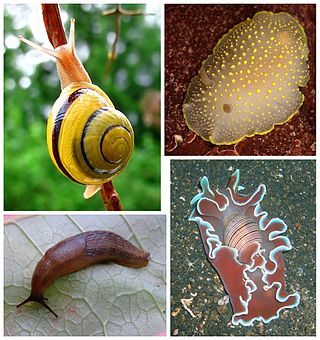
Heterobranchia, the heterobranchs, is a taxonomic clade of snails and slugs, which includes marine, aquatic and terrestrial gastropod mollusks.

Stylommatophora is an order of air-breathing land snails and slugs, terrestrial pulmonate gastropod molluscs. This taxon includes most land snails and slugs. Stylommatophorans lack an operculum, but some close their shell apertures with temporary "operculum" (epiphragm) made of calcified mucus. They have two pairs of retractile tentacles, the upper pair of which bears eyes on the tentacle tips. All stylommatophorans are hermaphrodites.

Conoidea is a superfamily of predatory sea snails, marine gastropod mollusks within the suborder Hypsogastropoda. This superfamily is a very large group of marine mollusks, estimated at about 340 recent valid genera and subgenera, and considered by one authority to contain 4,000 named living species.
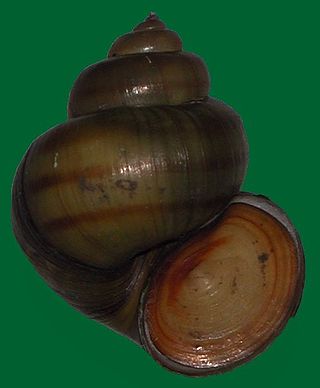
Viviparidae, sometimes known as the river snails or mystery snails, are a family of large operculate freshwater snails, aquatic gastropod mollusks.

Subulininae is a subfamily of small tropical air-breathing land snails, terrestrial pulmonate gastropod mollusks in the family Achatinidae.

Strophocheilidae is a taxonomic family of air-breathing land snails, terrestrial pulmonate gastropod mollusks in the superfamily Acavoidea.

Spiraxidae is a family of predatory air-breathing land snails, terrestrial pulmonate gastropods in the superfamily Testacelloidea.
Micractaeon koptawelilensis is a species of land snail, terrestrial gastropod mollusks in the superfamily Achatinoidea.

Urocoptidae is a family of air-breathing land snails, terrestrial pulmonate gastropod mollusks in the superfamily Urocoptoidea.

Vetigastropoda is a major taxonomic group of sea snails, marine gastropod mollusks that form a very ancient lineage. Taxonomically the Vetigastropoda are sometimes treated as an order, although they are treated as an unranked clade in Bouchet and Rocroi, 2005.

Sigmurethra is a taxonomic category of air-breathing land snails and slugs, terrestrial pulmonate gastropod molluscs. This is an informal group which includes most land snails and slugs.

The Limacoidei is a taxonomic infraorder of air-breathing land snails, semislugs and slugs, terrestrial pulmonate gastropod molluscs in the suborder Helicina
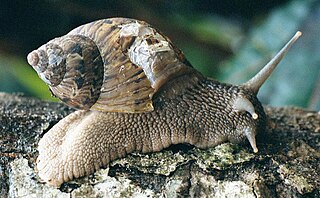
The Orthalicoidea are a superfamily of air-breathing land snails, terrestrial gastropod mollusks in the infraorder Orthalicoidei of the suborder Helicina
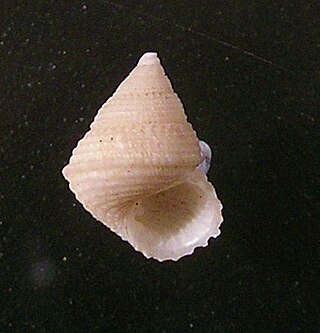
Seguenzioidea is a superfamily of minute to medium-sized sea snails, marine gastropod mollusks in the clade Vetigastropoda.
This overview lists proposed changes in the taxonomy of gastropods at the family level and above since 2005, when the taxonomy of the Gastropoda by Bouchet & Rocroi (2005) was published. In other words, these are recent updates in the way various groups of snails and slugs are classified.

Urocoptoidea is a superfamily of land snails, gastropods in the suborder Helicina.
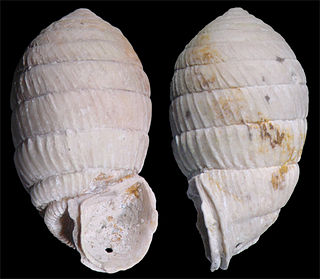
Brasilennea is a fossil genus of small to medium-sized air-breathing land snails, terrestrial pulmonate gastropods in the family Cerionidae. The genus is known only from the Brazilian Paleocene Itaboraí Basin, in Rio de Janeiro. The most characteristic feature of the genus is its two spiral furrows on the body whorl.

Brasilennea arethusae is a fossil species of air-breathing land snail, a terrestrial pulmonate gastropod mollusk in the family Cerionidae, from the Paleocene Itaboraí Basin, Brazil. Brasilennea arethusae is the largest species in the genus Brasilennea. It was one of the first fossils found in Itaboraí Basin and its name makes reference to the fact that it is a terrestrial species: the name is in honor of Arethusa, a sylvan nymph and one of the Hesperides from Greek mythology.
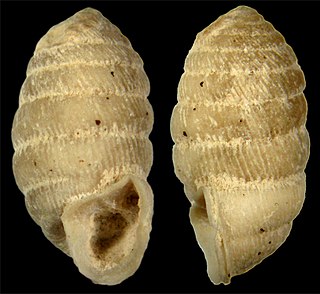
Brasilennea minor is a fossil species of air-breathing land snail, a terrestrial pulmonate gastropod mollusk in the family Cerionidae, from the Paleocene Itaboraí Basin, Brazil. Brasilennea minor is the smallest species in the genus Brasilennea; it was originally described as a smaller variant of Brasilennea arethusae, but was later raised to the rank of species.
Condonella is an extinct genus of land snail in the family Urocoptidae known from the fossil species Condonella suciensis of Western North America.















